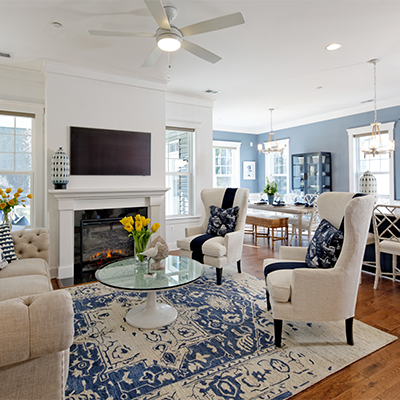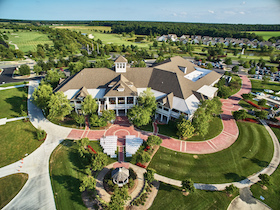Multi-Generational Housing: New Life for An Old Idea
Category: Retirement Real Estate
August 11, 2018 — For most of human history the most common housing model was for multi-generations to live under the same roof. In a typical scenario a widowed grandfather or grandmother would be living in a home with one of their married children, along with the children of that union. The generations chipped in to support the others – whether it was cooking, childcare, or financial – and typically enjoyed the benefit of living close together. The phenomenon became much less common in the 20th century. The advent of Social Security and financial independence of the elderly was probably one reason, and as nursing homes and assisted living became more common, the eldest generation had less need to live to in their children’s homes.
Today multi-generations living under the same roof is coming back. Armed with better architecture and modern thinking, people are finding ways to take advantage of their combined resources while minimizing the disadvantages. In fact the Pew Research Center found that 64 million Americans live in multigenerational homes, double the number from 1950. This article will talks about some of these changes.
One big reason why more families are looking to the multi-generational household is economic. Young adults are priced out of the housing market, but their parents usually have significant home equity they can leverage. They can use that to modify the home they are currently in, or they can afford to buy or build a new one that better suits the needs of different family members. Another reason driving the phenomenon is the skyrocketing cost of assisted and independent living. Finally, many immigrant families are more used to the idea of having different generations live in the same household.
Different Models
One model is buy, build, or modify a home so that it has separate living quarters. One of the units might be quite small, an in-law apartment with separate entrance, or perhaps even a tiny home built on the property. That provides enough separation so each family unit has privacy and space, yet keeps them close enough to enjoy family meals, casual interactions, and splitting chores and expenses. If you look online you will see all kinds of homes with interesting approaches to the multi-generational solution. Good planning, like extra soundproofing for seniors who need to listen to the TV with extra volume is important.
Another approach is to take advantage of larger developments that feature different kinds of living units. Some all age communities like Five Knolls in Santa Clarita (CA) and Agave La Floresta (Brea, CA) have 55+ neighborhoods within them, so the generations can live close to one another, but not too close. Similarly, adjacent townhomes can provide another solution. Realize, however, this might not be the cheapest solution to the problem.
Issues
A big issue with more than one generation living in close proximity to one another is to figure how to do it without causing strife. There have to be mechanisms in place to resolve issues, whether financial or other, without undoing the partnership. One of the best ways to do that is with something akin to a prenup agreement. Typically that specifies who pays for what, how finances are combined, what happens if a party wants to move out, how household chores will be allocated, and what happens if there is breakup. You can probably find an attorney in your area who is experienced at drafting such a letter.
Sometimes one party might feel aggrieved, so there has to be a way to resolve that. For example the eldest generation might feel they are being taken advantage of when it comes to childcare – drafted into caring or chauffeuring more than they want. Someone else might feel that they do too much of the household work or maintenance. Young adults might either feel they don’t have enough independence, or their parents don’t approve of their lifestyle, friends, or entertaining. Families that successfully live together come to realize that talking with one other frequently and getting issues into the open is the best way to keep harmony in the long run.
If you do decide to join generations in the same home
List your must haves
Before you buy or build, make sure all parties have expressed and agreed to their list of must-haves in the new home. A compromise that leaves one party feeling shorted could become problematic. For example, is the in-law apartment of sufficient size that it doesn’t feel like an afterthought.
Have an exit strategy
Some day one or more parties might realize that the arrangement isn’t working out. If you have an agreement in advance that everyone has agreed to it will make that exit a lot easier. Hiring a lawyer with some experience in this area to create the document is a must.
Allow for change
One or both older parents will die eventually. What happens then? What if the younger generation adds more children and doesn’t fit in the home anymore? How about when the oldest generation starts to need more care – what will happen then? Nothing lasts forever and anything can change. That’s why a good agreement will help you through it.
Who does what
Someone needs to be in charge of things like finances, maintenance, renovations, cleaning, etc. If there are children in the home, what are the expectations and limits for the non-parents? If you haven’t spelled this out, one or more parties might feel aggrieved. You can always change the agreement if people talk and try to work things out.
Who pays for what
You can pool your funds into a household account or agree that certain parties are responsible for certain items. For example one person might own the home and the others contribute by paying items like taxes or maintenance
Who owns what
This can become complicated and depends on the situation. One couple might have the equity and money to own the whole property. Or it might be shared. Perhaps one couple buys in gradually, or gets the property in the estate. You do need to plan this out and get agreement in advance.
Keep talking
As you can see from the complexity involved, there will be wrinkles down the road. If you agree going in that you will all discuss issues as they come up you can avoid some big headaches.
Final word…
One person quoted in a NY Times article on this topic had a great suggestion: “Buy a lot of TVs so everybody can watch their own shows!”
Comments? Are you interested in sharing a home with other family members? If so, what kind of issues and experiences did you run into? Please share your thoughts in the Comments section below.
For further reading:
Tiny Homes Movement
What to Know Before Buying a Home with Your Parents






Comments on "Multi-Generational Housing: New Life for An Old Idea"
Ashley Hoober says:
Looking into living with our children and grandchildren for cultural reasons! will certainly share this post with them
Daryl says:
I wish our municipality allowed an additional tiny home or “ohana unit” on our lots strictly for extended families. It would solve the temporary returning adult child, widowed grandma situations. Everybody here has a giant shed in their backyard, a tiny house isn’t much larger.
Jennifer says:
The Amish call it a "Daudy House". It is a small house on the property, sometimes attached to the main house, often not, for the older generation to move into as they age up. It works for them.
Admin says:
We just saw a nifty article on this phenomenon, specifically on prefab "accessory dwelling units". The designer Yves Behar says they are catching on for many reasons. For one, prefab units can be dropped onto a site with minimum disruption and installed in a day. Built at a factory, they can be customized from a variety of styles to fit the needs of the people who are going to live in them. See " A Fix for the Housing Shortage May Sit in Your Backyard"
https://www.nytimes.com/2018/10/31/realestate/yes-in-your-backyard.html
Admin says:
Accessory Dwelling Units (ADUs) are another great way for for multiple generations to live on the same property. California actually encourages them as a way to solve their housing shortage. Usually about 800 sq. ft., they are small but practical. See https://www.nextavenue.org/accessory-dwelling-unit-help-aging-parent/